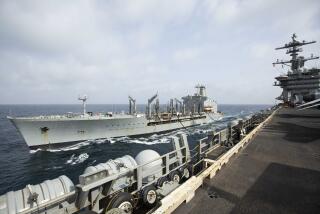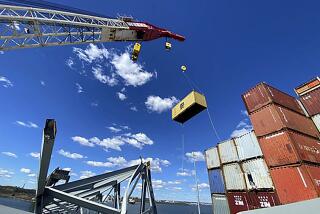7th Plate Is Peeling Off Valdez; Concern Voiced for 1st Time Over Seaworthiness
- Share via
SAN DIEGO — A seventh steel plate has begun peeling downward from the hull of the crippled Exxon Valdez, and officials Friday for the first time expressed concern about the threat to the ship’s seaworthiness.
Jan Cool, a spokeswoman for Exxon Shipping Co., said the weight of the plates--as much as 35 tons apiece--is causing them to pull farther away from the hull and at some point, “will affect the integrity of the ship.”
While the plates are a sort of skin on the hull and are not themselves crucial to the ship’s seaworthiness, Cool said that “one plate potentially could peel back and affect a ballast tank.”
“If that happens, we could have serious problems keeping the ship afloat,” Cool said.
“The ship now is fully operational,” she said, adding, “It would take a substantial amount” of peeling before the plate reached the ballast tank, which holds water that keeps the ship stable.
The discovery late Thursday of a seventh peeling plate, about 20 feet by 48 feet, and further peeling of the original six plates led to the heightened concern.
Meanwhile, the state and Exxon Shipping were on the verge of reaching an agreement that would allow the crippled tanker to enter state waters. They have successfully negotiated two critical conditions on the oil company’s liability, a source close to the proceedings said.
Offshore, calm seas with swells up to about two feet allowed divers to begin cutting some of the steel plates dangling from the ship’s hull.
Samples collected Monday from a blue sheen sighted 10 miles south of the tanker proved to be waste water from a ship’s bilge. The waste water was not believed to have come from the crippled vessel, the Coast Guard said.
Off La Jolla
The Valdez on Friday was about seven miles northeast of Pyramid Head on San Clemente Island and about 54 miles off La Jolla.
Divers from the Portland-based Fred Devine Diving and Salvage Co., the same company that did initial repairs to the tanker’s hull in Alaska, on Friday were able to attach cables to some of the plates to prevent them from falling after being cut. They also cut off a small piece of metal that had prevented the crew from reaching one of the plates, Cool said.
The diving team was expected to decide late Friday whether the plate removal could be done outside state waters. Since Wednesday, the divers have been testing the waters for possible removal of the plates, which jut down as much as 70 feet from the hull. But open-sea conditions, such as swells up to seven feet Thursday afternoon, have delayed the process.
“I think there’s sincere concern not about the structural integrity of the ship but of the status of the plates peeling away,” Cool said.
The plates peeled back during the vessel’s 2,200-mile trip from Alaska’s Prince William Sound to San Diego. The hanging plates are preventing the ship from entering San Diego Bay, where the vessel is expected to go into dry dock at the National Steel and Shipbuilding Co. for a nine-month, $25-million repair job.
More to Read
Sign up for Essential California
The most important California stories and recommendations in your inbox every morning.
You may occasionally receive promotional content from the Los Angeles Times.










